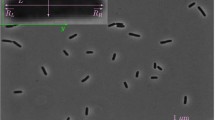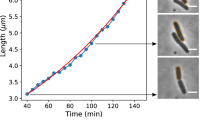Abstract
A combination of light-microscopy and image processing has been applied to study naturally deformed Escherichia coli under in vivo condition and at the order of sub-pixel high-resolution accuracy. To classify deflagellated non-dividing E. coli cells to the rod-shape and bent-shape, a geometrical approach has been applied. From the analysis of the geometrical data which were obtained of image processing, we estimated the required effective energy for shaping a rod-shape to a bent-shape with the same size. We evaluated the energy of deformation in the naturally deformed bacteria with minimum cell manipulation, under in vivo condition, and with minimum influence of any external force, torque and pressure. Finally, we have also elaborated on the possible scenario to explain how naturally deformed bacteria are formed from initial to final-stage.



Similar content being viewed by others
References
Amir A (2014) Cell size regulation in bacteria. Phys Rev Lett 112(20):208,102
Amir A, Nelson DR (2012) Dislocation-mediated growth of bacterial cell walls. Proc Natl Acad Sci 109(25):9833–9838
Amir A, van Teeffelen S (2014) Getting into shape: how do rod-like bacteria control their geometry? Syst Synth Biol 8(3):227–235
Amir A, Babaeipour F, McIntosh DB, Nelson DR, Jun S (2014) Bending forces plastically deform growing bacterial cell walls. Proc Natl Acad Sci 111(16):5778–5783
Arnoldi M, Fritz M, Bäuerlein E, Radmacher M, Sackmann E, Boulbitch A (2000) Bacterial turgor pressure can be measured by atomic force microscopy. Phys Rev E 62(1):1034
Beeby M, Gumbart JC, Roux B, Jensen GJ (2013) Architecture and assembly of the gram-positive cell wall. Mol Microbiol 88(4):664–672
Bendezu FO, Hale CA, Bernhardt TG, de Boer PA (2009) Rodz (yfga) is required for proper assembly of the mreb actin cytoskeleton and cell shape in e. coli. EMBO J 28(3):193–204
Boulbitch A, Quinn B, Pink D (2000) Elasticity of the rod-shaped gram-negative eubacteria. Phys Rev Lett 85(24):5246
Cabeen MT, Jacobs-Wagner C (2007) Skin and bones: the bacterial cytoskeleton, cell wall, and cell morphogenesis. J Cell Biol 179(3):381–387
Cabeen MT, Charbon G, Vollmer W, Born P, Ausmees N, Weibel DB, Jacobs-Wagner C (2009) Bacterial cell curvature through mechanical control of cell growth. EMBO j 28(9):1208–1219
Cooper S, Denny MW (1997) A conjecture on the relationship of bacterial shape to motility in rod-shaped bacteria. FEMS Microbiol Lett 148(2):227–231
Deng Y, Sun M, Shaevitz JW (2011) Direct measurement of cell wall stress stiffening and turgor pressure in live bacterial cells. Phys Rev Lett 107(15):158,101
Dusenbery DB (2009) Living at micro scale: the unexpected physics of being small. Harvard University Press
Eun YJ, Kapoor M, Hussain S, Garner EC (2015) Bacterial filament systems: towards understanding their emergent behavior and cellular functions. J Biol Chem:jbc–R115
Furchtgott L, Wingreen NS, Huang KC (2011) Mechanisms for maintaining cell shape in rod-shaped gram-negative bacteria. Mol Microbiol 81(2):340–353
Gray AN, Egan AJ, van’t Veer IL, Verheul J, Colavin A, Koumoutsi A, Biboy J, Altelaar MA, Damen MJ, Huang KC et al (2015) Coordination of peptidoglycan synthesis and outer membrane constriction during escherichia coli cell division. eLife :e07118
Grover N, Woldringh C (2001) Dimensional regulation of cell-cycle events in escherichia coli during steady-state growth. Microbiology 147(1):171–181
Guberman JM, Fay A, Dworkin J, Wingreen NS, Gitai Z (2008) Psicic: noise and asymmetry in bacterial division revealed by computational image analysis at sub-pixel resolution. PLoS Comput Biol 4(11):e1000,233
Gumbart JC, Beeby M, Jensen GJ, Roux B (1003) Escherichia coli peptidoglycan structure and mechanics as predicted by atomic-scale simulations. Plos Comput Biol 10:475
Harold FM (1990) To shape a cell: an inquiry into the causes of morphogenesis of microorganisms. Microbiol Rev 54(4):381
Huang KC, Ramamurthi KS (2010) Macromolecules that prefer their membranes curvy. Mol Microbiol 76(4):822–832
Huang KC, Mukhopadhyay R, Wingreen NS (2006) A curvature-mediated mechanism for localization of lipids to bacterial poles. PLoS Comput Biol 2(11):e151
Huang KC, Mukhopadhyay R, Wen B, Gitai Z, Wingreen NS (2008) Cell shape and cell-wall organization in gram-negative bacteria. Proc Natl Acad Sci 105(49):19,282–19,287
Itan E, Carmon G, Rabinovitch A, Fishov I, Feingold M (2008) Shape of nonseptated escherichia coli is asymmetric. Phys Rev E 77(6):061,902
Iyer-Biswas S, Wright CS, Henry JT, Lo K, Burov S, Lin Y, Crooks GE, Crosson S, Dinner AR, Scherer NF (2014) Scaling laws governing stochastic growth and division of single bacterial cells. Proc Natl Acad Sci 111(45):15,912–15,917
Jauffred L, Callisen TH, Oddershede LB (2007) Visco-elastic membrane tethers extracted from escherichia coli by optical tweezers. Biophys J 93(11):4068–4075
Jiang H, Si F, Margolin W, Sun SX (2011) Mechanical control of bacterial cell shape. Biophys J 101(2):327–335
Kawai Y, Marles-Wright J, Cleverley RM, Emmins R, Ishikawa S, Kuwano M, Heinz N, Bui NK, Hoyland CN, Ogasawara N et al (2011) A widespread family of bacterial cell wall assembly proteins. EMBO J 30(24):4931–4941
Laloux G, Jacobs-Wagner C (2014) How do bacteria localize proteins to the cell pole? J Cell Sci 127(1):11–19
Lan G, Wolgemuth CW, Sun SX (2007) Z-ring force and cell shape during division in rod-like bacteria. Proc Natl Acad Sci 104(41):16,110–16,115
Männik J, Wu F, Hol FJ, Bisicchia P, Sherratt DJ, Keymer JE, Dekker C (2012) Robustness and accuracy of cell division in escherichia coli in diverse cell shapes. Proc Natl Acad Sci 109(18): 6957–6962
Margolin W (2009) Sculpting the bacterial cell. Curr Biol 19(17):R812–R822
Mukhopadhyay R, Wingreen NS (2009) Curvature and shape determination of growing bacteria. Phys Rev E 80(6):062,901
Mukhopadhyay R, Huang KC, Wingreen NS (2008) Lipid localization in bacterial cells through curvature-mediated microphase separation. Biophys J 95(3):1034–1049
Nelson DR (2012) Biophysical dynamics in disorderly environments. Annu Rev Biophys 41:371–402
Nguyen LT, Gumbart JC, Beeby M, Jensen GJ (2015) Coarse-grained simulations of bacterial cell wall growth reveal that local coordination alone can be sufficient to maintain rod shape. Proc Natl Acad Sci 112(28):E3689–E3698
Olrichs NK, Aarsman ME, Verheul J, Arnusch CJ, Martin NI, Hervé M, Vollmer W, de Kruijff B, Breukink E, den Blaauwen T (2011) A novel in vivo cell-wall labeling approach sheds new light on peptidoglycan synthesis in escherichia coli. ChemBioChem 12(7):1124–1133
Osborn MJ, Rothfield L (2007) Cell shape determination in escherichia coli. Curr Opin Microbiol 10(6):606–610
Phillips R, Quake S (2006) The biological frontier of physics. Phys Today 59(5):38–43
Ploeg R, Verheul J, Vischer NO, Alexeeva S, Hoogendoorn E, Postma M, Banzhaf M, Vollmer W, Blaauwen T (2013) Colocalization and interaction between elongasome and divisome during a preparative cell division phase in escherichia coli. Mol Microbiol 87(5):1074–1087
Rabinovitch A, Zaritsky A, Feingold M (2003) Dna–membrane interactions can localize bacterial cell center. J Theor Biol 225(4):493–496
Renner LD, Weibel DB (2011) Cardiolipin microdomains localize to negatively curved regions of escherichia coli membranes. Proc Natl Acad Sci 108(15):6264–6269
Ruiz N, Kahne D, Silhavy TJ (2006) Advances in understanding bacterial outer-membrane biogenesis. Nat Rev Microbiol 4(1):57–66
Schirner K, Eun YJ, Dion M, Luo Y, Helmann JD, Garner EC, Walker S (2014) Lipid-linked cell wall precursors regulate membrane association of bacterial actin mreb. Nature chemical biology
Shiomi D, Sakai M, Niki H (2008) Determination of bacterial rod shape by a novel cytoskeletal membrane protein. EMBO J 27(23):3081–3091
Silhavy TJ, Kahne D, Walker S (2010) The bacterial cell envelope. Cold Spring Harbor perspectives in biology 2(5):a000,414
Sliusarenko O, Cabeen MT, Wolgemuth CW, Jacobs-Wagner C, Emonet T (2010) Processivity of peptidoglycan synthesis provides a built-in mechanism for the robustness of straight-rod cell morphology. Proc Natl Acad Sci 107(22):10,086–10,091
Sun SX, Jiang H (2011) Physics of bacterial morphogenesis. Microbiol Mol Biol Rev 75(4):543–565
Tavaddod S, Charsooghi M, Abdi F, Khalesifard H, Golestanian R (2011) Probing passive diffusion of flagellated and deflagellated escherichia coli. Eur Phys J E 34(2):1–7
Turner RD, Hurd AF, Cadby A, Hobbs JK, Foster SJ (2013) Cell wall elongation mode in gram-negative bacteria is determined by peptidoglycan architecture. Nat Commun 4:1496
Turner RD, Vollmer W, Foster SJ (2014) Different walls for rods and balls: the diversity of peptidoglycan. Mol Microbiol 91(5):862–874
Typas A, Banzhaf M, Gross CA, Vollmer W (2012) From the regulation of peptidoglycan synthesis to bacterial growth and morphology. Nat Rev Microbiol 10(2):123–136
Ursell TS, Nguyen J, Monds RD, Colavin A, Billings G, Ouzounov N, Gitai Z, Shaevitz JW, Huang KC (2014) Rod-like bacterial shape is maintained by feedback between cell curvature and cytoskeletal localization. Proc Natl Acad Sci 111(11):E1025–E1034
Vardi E, Grover N (1992) Aggregation of escherichia coli b/r a during agar filtration: Effect on morphometric measurements. Cytometry 13(5):540–544
Vardi E, Grover N (1993) Shape changes in escherichia coli b/r a during agar filtration. Cytometry 14(2):173–178
Vischer N, Verheul J, Postma M, Van˙den˙berg˙van˙saparoea B, Galli E, Natale P, Gerdes K, Luirink J, Vollmer W, Vicente M et al (2015) Cell age dependent concentration of escherichia coli divisome proteins analyzed with imagej and object. Name: Front Microbiol 6:586
Wang S, Wingreen NS (2013) Cell shape can mediate the spatial organization of the bacterial cytoskeleton. Biophys J 104(3):541–552
Wang S, Arellano-Santoyo H, Combs PA, Shaevitz JW (2010) Actin-like cytoskeleton filaments contribute to cell mechanics in bacteria. Proc Natl Acad Sci 107(20):9182–9185
Woldringh C, Grover N, Rosenberger R, Zaritsky A (1980) Dimensional rearrangement of rod-shaped bacteria following nutritional shift-up. ii. experiments with escherichia colibr. J Theor Biol 86(3):441–454
Woldringh CL (2002) The role of co-transcriptional translation and protein translocation (transertion) in bacterial chromosome segregation. Mol Microbiol 45(1):17–29
Yao X, Jericho M, Pink D, Beveridge T (1999) Thickness and elasticity of gram-negative murein sacculi measured by atomic force microscopy. J Bacteriol 181(22):6865–6875
Young KD (2006) The selective value of bacterial shape. Microbiol Mol Biol Rev 70(3):660–703
Young KD (2007) Bacterial morphology: why have different shapes? Curr Opin Microbiol 10(6):596–600
Zaritsky A (2015) Cell-shape homeostasis in escherichia coli is driven by growth, division, and nucleoid complexity. Biophys J 109(2):178–181
Zaritsky A, Woldringh CL (2015) Chromosome replication, cell growth, division and shape: a personal perspective. Front Microbiol:6
Zaritsky A, Woldringh CL, Mirelman D (1979) Constant peptidoglycan density in the sacculus of escherichia coli b/r growing at different rates. FEBS Lett 98(1):29–32
Zaritsky A, Woldringh CL, Pritchard R, Fishov I (2000) Surviving escherichia coli in good shape: The many faces of bacillary bacteria in cellular origin and life in extreme habitats
Zimmerberg J, Kozlov MM (2006) How proteins produce cellular membrane curvature. Nat Rev Mol Cell Biol 7(1):9–19
Acknowledgments
It is a pleasure to thank Howard C. Berg and Karen Fahrner for kindly providing the E. coli strain HCB137. Special thanks go to Conrad L. Woldringh for his help in providing the strain, his expert advices and very interesting discussions. His suggestions and remarks significantly improved this study. We are immensely grateful to Ramin Golestanian for the original idea of the manuscript. We would like to acknowledge Ramin Golestanian, M. Faez Miri, Daivid Nelson, Ariel Amir, Nader Rasouli, and Jafar Amjad for enlightening remarks.
Author information
Authors and Affiliations
Corresponding author
Rights and permissions
About this article
Cite this article
Tavaddod, S., Naderi-Manesh, H. In Vivo study of naturally deformed Escherichia coli bacteria. J Bioenerg Biomembr 48, 281–291 (2016). https://doi.org/10.1007/s10863-016-9658-8
Received:
Accepted:
Published:
Issue Date:
DOI: https://doi.org/10.1007/s10863-016-9658-8




